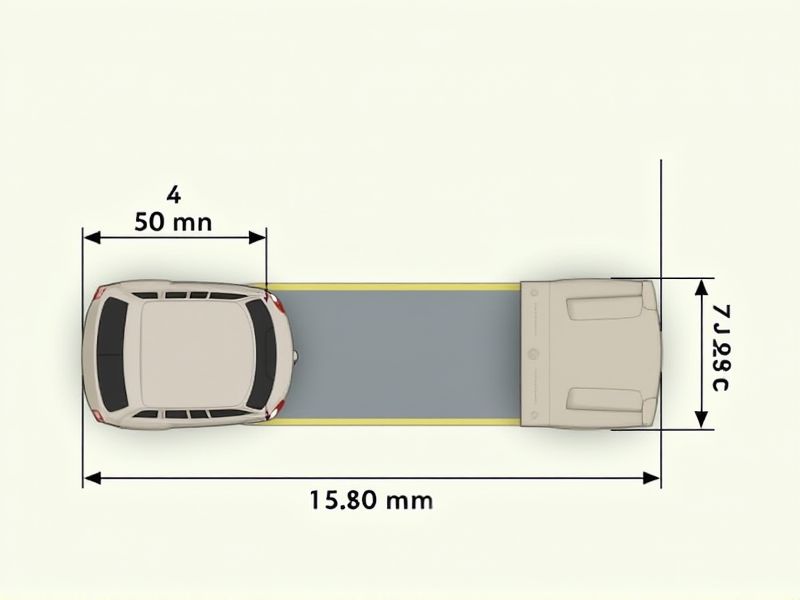
The standard dimensions for a residential driveway typically range from 9 to 12 feet wide for a single car, allowing enough space for safe entry and exit from the vehicle. For a double-car driveway, a common width is 18 to 24 feet, accommodating two vehicles side by side while providing ample clearance. Driveway lengths usually range between 18 and 20 feet per vehicle to ensure the entire car fits without extending onto sidewalks or streets. Before finalizing your plans, it's always a good idea to check local zoning codes or homeowners' association guidelines, as requirements may vary depending on where you live.
Minimum Width
The standard minimum width for a residential driveway typically ranges from 10 to 12 feet, ensuring adequate space for maneuvering vehicles safely. For dual-lane driveways, increasing the width to 20 to 24 feet is recommended to accommodate two vehicles side by side. It is essential to consider local zoning regulations, which may impose specific requirements on driveway dimensions in your area. Properly designed driveways not only enhance traffic flow but also contribute to the overall curb appeal of your property.
Length For Parking
The standard length for a residential driveway typically ranges from 18 to 20 feet, providing ample space for parking one vehicle comfortably. If you plan to park two cars side by side, a driveway width of at least 20 feet is recommended to allow for easy maneuverability. For optimal utility, consider that a standard-sized vehicle is about 6 to 7 feet wide, necessitating additional width for door clearance and passenger entry. Accommodating these dimensions ensures your driveway can serve its primary purpose without hindrance.
Turning Radius
The turning radius for a standard residential driveway typically ranges from 10 to 15 feet to accommodate smooth vehicle navigation. A radius of 12 feet is optimal for most passenger vehicles, allowing for easy entry and exit without scraping the vehicle's edges. In contrast, larger vehicles, such as SUVs or trucks, may require a radius closer to 15 feet for maneuverability. Ensuring an adequate turning radius in your driveway design can enhance safety and accessibility, significantly improving your overall parking experience.
Slope Or Grade
The standard slope for residential driveways typically ranges from 1% to 5%, ensuring effective drainage and vehicle accessibility. A grade exceeding 10% may lead to difficulties for most vehicles, particularly in adverse weather conditions. Driveways must be designed to facilitate runoff, preventing water pooling that can cause erosion or structural damage. To optimize accessibility and safety in your driveway, consider maintaining a uniform slope that meets local building codes and regulations.
Material Thickness
The standard material thickness for driveways typically ranges between 4 to 6 inches, depending on the load it will bear. Concrete driveways require at least 4 inches of thickness for standard vehicles, whereas driveways intended for heavier loads might need up to 6 inches to ensure durability and prevent cracking. For asphalt driveways, a thickness of 2.5 to 3 inches is generally sufficient, with the underlying base material playing a crucial role in support. Properly managing material thickness not only enhances longevity but also improves the aesthetic appeal of your driveway.
Edge Clearance
Edge clearance for driveways should ideally measure at least 2 feet from the property line to facilitate safe vehicle access and prevent encroachment on adjacent landscapes. This distance helps avoid potential damage to surrounding trees, shrubs, and other plant life, contributing to a more harmonious environment. Local zoning regulations often stipulate these clearance requirements, which can vary significantly depending on your area, so it's important to check before construction begins. Ensuring proper edge clearance not only promotes safety but also enhances the longevity of both your driveway and the adjacent landscaping.
Ada Requirements
Driveway design must adhere to the Americans with Disabilities Act (ADA) standards, emphasizing accessibility for individuals with disabilities. The maximum slope for accessible driveways is set at 1:12, ensuring easy navigation for wheelchair users. It is crucial to maintain a surface width of at least 36 inches to accommodate various mobility devices. Incorporating tactile warning surfaces near transitions between walkways and driveways enhances safety for visually impaired users.
Drainage Slope
A driveway should ideally have a drainage slope of 1-2%, ensuring efficient water runoff and preventing water pooling. This slight incline directs rainwater away from your home, reducing the risk of flooding and erosion. Proper drainage designs should include gutters or swales to enhance water diversion and protect the driveway's integrity. Maintaining this slope is crucial for durability, as it minimizes damage from freeze-thaw cycles, extending the lifespan of your driveway.
Off-Street Parking Dimension
The standard dimension for off-street parking in residential driveways typically measures 9 feet wide by 18 feet long per vehicle, accommodating the average car size. For more extensive vehicles, such as SUVs or trucks, a width of 10 to 12 feet is recommended to ensure comfortable access and maneuverability. The overall driveway width should ideally be at least 20 feet to allow for two vehicles to pass side by side safely. Local zoning regulations may also dictate specific requirements that can vary, so it's essential to check your area's guidelines before construction.
Curb Cut Width
Curb cut width, a critical aspect of driveway design, typically ranges from 10 to 20 feet, depending on local regulations and vehicle sizes. A properly designed curb cut ensures smooth access for cars and increases safety for pedestrians. You should consider a wider curb cut for larger vehicles or if the driveway is expected to accommodate turning movements frequently. Maintaining an appropriate slope, ideally at 1:12, helps prevent water pooling and enhances overall drainage efficiency.
